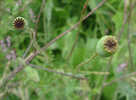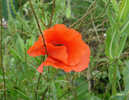

 The common poppy is a welcome sight throughout most of the UK (but grow world wide) although it is less frequent in Wales, north –west England and Scotland. Many myths surround the poppy which lead many to believe that it is poisonous or contains opium narcotic. Folk lore attributes the poppy the power to make you go blind by staring at it or its scent causing headaches. The seeds are in fact totally harmless and even the seeds of the opium poppy are harvested commercially to produce the seeds sold in super markets for baking. The Common poppy's seeds can also be eaten but lack the flavour of the commercial opium poppy seeds.
The common poppy is a welcome sight throughout most of the UK (but grow world wide) although it is less frequent in Wales, north –west England and Scotland. Many myths surround the poppy which lead many to believe that it is poisonous or contains opium narcotic. Folk lore attributes the poppy the power to make you go blind by staring at it or its scent causing headaches. The seeds are in fact totally harmless and even the seeds of the opium poppy are harvested commercially to produce the seeds sold in super markets for baking. The Common poppy's seeds can also be eaten but lack the flavour of the commercial opium poppy seeds.
 The seeds are easy to harvest in mid to late September once the seed heads turn dry and brown. Pick these being careful to keep them upright until placed into a paper bag. The seed heads have tiny vents in the top and once dry gentle shaking will make the tiny seeds drop out. They offer little nutritional value due to their small size but do add flavour to cakes and breads or in honey as a dressing. Roast them in a small pan or lid and then add them to soups for extra texture and flavour. Medicinally they are used as an expectorant to treat coughs or to colour some medicines.
The seeds are easy to harvest in mid to late September once the seed heads turn dry and brown. Pick these being careful to keep them upright until placed into a paper bag. The seed heads have tiny vents in the top and once dry gentle shaking will make the tiny seeds drop out. They offer little nutritional value due to their small size but do add flavour to cakes and breads or in honey as a dressing. Roast them in a small pan or lid and then add them to soups for extra texture and flavour. Medicinally they are used as an expectorant to treat coughs or to colour some medicines.
Common poppy’s normally flower between May and July in the UK and are found around the edges of paths and arable land. In the UK they are associated with Remembrance Day and the First World War as after the armistice the shell fire had disturbed many seeds lying dormant leading to many of the battlefields having a covering of poppies when the war ended.
What Culpeper says (Culpeper lists several entries for various types of poppy)
WILD POPPY
Name. Called also Corn-rose.
Description. The Wild Poppy, or Corn Rose, hath long and narrow leaves, very much cut in on the edges into many divisions, of a light green colour, sometimes hairy withal. The stalk is blackish and hairy also, but not so tall as the garden kind, having some such like leaves thereon to grow below, parted into three or four branches sometimes, whereon grow small hairy heads bowing down before the skin break, wherein the flower is inclosed, which when it is fully blown open, is of a fair yellowish red or crimson colour, and in some much paler, without any spot in the bottom of the leaves, having many black soft threads in the middle, compassing a small green head, which when it is ripe, is not bigger than one's little finger's end, wherein is contained much black seeds smaller than that of the garden. The root perishes every year, and springs again of its own sowing. Of this kind there is one lesser in all parts thereof, and differs in nothing else.
Place. The garden kinds do not naturally grow wild in any place, but all are sown in gardens where they grow.
The Wild Poppy or Corn Rose, is plentifully enough, and many times too much so in the corn fields of all counties through this land, and also on ditch banks, and by hedge sides. The smaller wild kind is also found in corn fields, and also in some other places, but not so plentifully as the former.
Time. The garden kinds are usually sown in the spring, which then flower about the end of May, and somewhat earlier, if they spring of their own sowing.
The wild kind flower usually from May until July, and the seed of them is ripe soon after the flowering.
Virtues. The herb is Lunar, and of the juice of it is made opium; only for lucre of money they cheat you, and tell you it is a kind of tear, or some such like thing, that drops from Poppies when they weep, and that is somewhere beyond the seas, I know not where beyond the Moon. The garden Poppy heads with seeds made into a syrup, is frequently, and to good effect used to procure rest, and sleep, in the sick and weak, and to stay catarrhs and defluxions of thin rheums from the head into the stomach and lungs, causing a continual cough, the fore-runner of a consumption; it helps also hoarseness of the throat, and when one have lost their voice, which the oil of the seed doth likewise. The black seed boiled in wine, and drank, is said also to dry the flux of the belly, and women's courses. The empty shells, or poppy heads, are usually boiled in water, and given to procure rest and sleep: so doth the leaves in the same manner; as also if the head and temples be bathed with the decoction warm, or with the oil of the poppies, the green leaves or heads bruised, and applied with a little vinegar, or made into a poultice with barleymeal or hog's grease, cools and tempers all inflammations; as also the diesase called St. Anthony's fire. It is generally used in treacle and mithridate, and in all other medicines that are made to procure rest and sleep, and to ease pains in the head as well as in other parts. It is also used to cool inlfammations, agues or phrenzies, or to stay defluxions which cause a cough, or consumption, and also other fluxes of the belly, or women's courses; it is also put into hollow teeth, to ease the pain, and has been found by experience to ease the pains of the gout.
The wild poppy, or corn-rose (as Matthiolus says) is good to prevent the falling-sickness. The syrup made with the flower, is with good effect given to those that have the pleurisy: and the dried flowers also, either boiled in water, or made into powder and drank, either in the distilled water of them, or some other drink, works the like effect. The distilled water of the flowers is held to be much good use against surfeits, being drank evening and morning: it is also more cooling than any of the other poppies, and therefore cannot but be as effectual in hot agues, phrenzies, and other inflammations either inward or outward. Galen says, the seed is dangerous to be used inwardly.
LONG ROUGH-HEADED POPPY
Description. The first leaves of this poppy grow in a cluster; they are of a pale green, and hairy, and have short foot-stalks; they are deeply divided on the pinnated manner, so that they seem composed of many pairs placed on a rib, with an odd one at teh end; but they are in reality only so many segments. The stalks are numerous, round, firm, very much branched, and a foot high. The flowers stnad at the tops of the branches, and are of a beautiful scarlet colour, with little black buttons. The heads are long, and covered with a kind of soft prickles.
Place. It is most common in in many parts of England in corn-fields, and on ditch-banks:
ROUND ROUGH-HEADED POPPY
Description. This has a long, slender, white root, with a few fibres. The first leaves are numerous and beautifully divided into segments; they have foot stalks, and are of a pale green, and uncommonly hairy. They are doubly pinnated, as it were, each consisting of several pairs of them in a middle rib, and each so doubly jagged, that they appear pinnated again. The stalk is round, rough, hairy, upright, branced, and a foot and half high. The leaves are numerous, and stand irregularly: they are of the same form with the lower ones, but smaller. The flowers are small in comparison of the preceeding kind, otherwise not little in proportion to the plant: they are of a bright red, and consist each of four petals with numerous threads. The seed-vessel is roundish and very rough, being set all over with a kind of bristly hair: the seeds are numerous, small, roundish, and black.
Place. It is most common in corn-fields in many parts of England.
Time. It flowers in July.
LONG SMOOTH-HEADED POPPY
Description. This poppy has fewer leaves, and they stand irregularly upon long foot-stalks; they are properly of the pinnated kind, and very beautiful, of a fine green. The flowers stand at the tops of the stalks, and are large and yellow, with purple buttons in their centre.
Place. It is frequently found in Wales wild, upon the moist rocks, and about the borders of rivulets.
Time. It flowers about the same time with the rest.